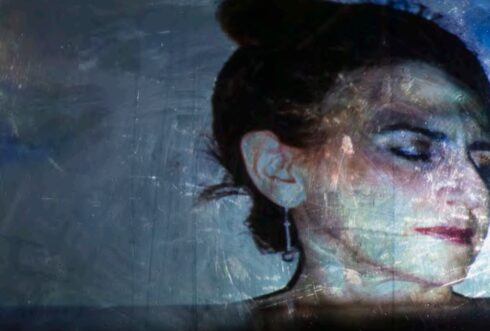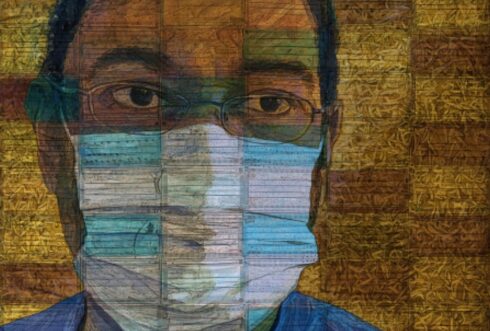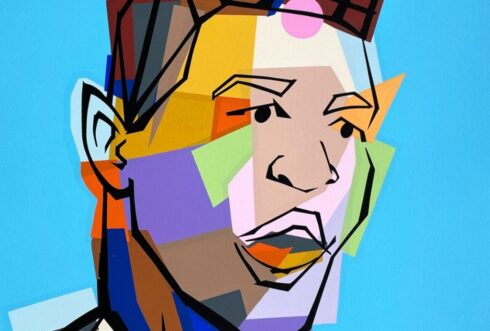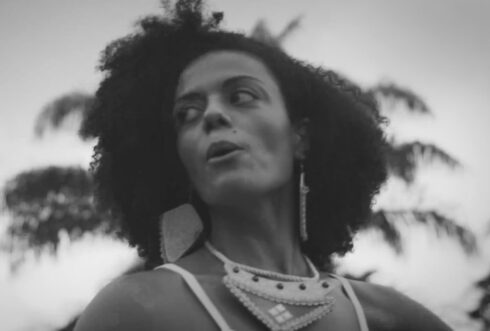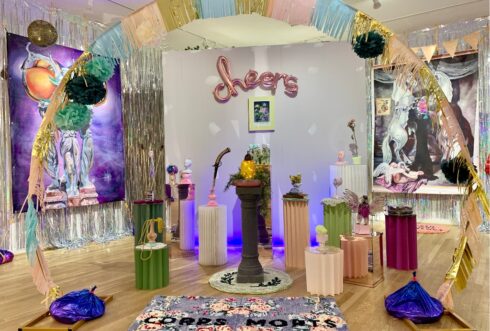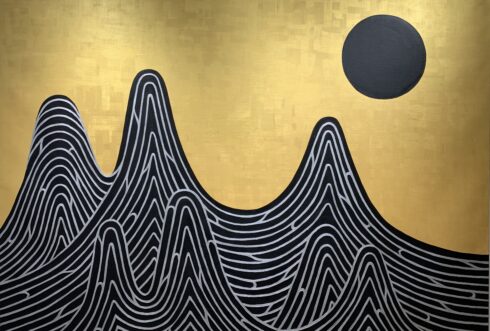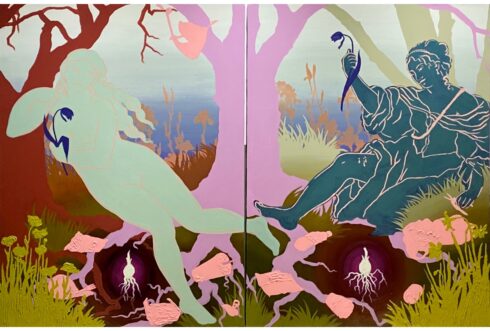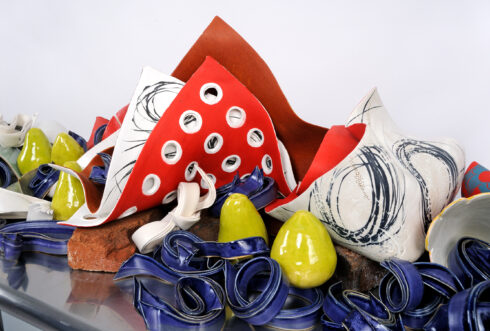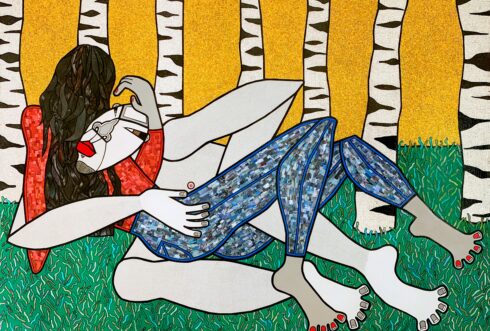Newly Selected Artists: Jeremy Jirsa, Lynn Alleva Lilley, and Heather Goodchild
Newly Selected Artists: Jeremy Jirsa, Lynn Alleva Lilley, and Heather Goodchild
August 6-August 28, 2022.
Jeremy Jirsa
Gray Area
“Gray area” is defined as an ill-defined situation or field not readily conforming to a category or to an existing set of rules. Within my show Gray Area, I analyze the socioeconomic factors that produced the “blue collar veil,” through which I interpreted the world in adolescence and young adulthood.
I explore my relationship with PTSD, mental illness, self-medication, and the space between old habits and learned behaviors; the differences between medicine and poison (e.g., dosage and intent); and the relationships that stem from my reactions to bouts with Tourette’s, severe OCD, anxiety, and depression, ultimately leading to the overwhelming projection of a façade to the world through a smile, while suffering in secret.
Artist Statement
While bringing my Tourette’s Syndrome to the forefront of my practice, I find my work exploring tones of isolation, self-medication, and depression, ultimately offering a perspective of Tourette’s through a false façade of perceived reality. My Tourette’s manifests itself through throat-clearing and the making of sounds, along with arm/shoulder spasms and head-jerking. These factors, coupled with severe OCD, lead to a vicious cycle of the controlled and uncontrollable feeding off each other. Living with this ailment has left me in chronic pain, at times unable to function due to extreme tics. It makes one feel trapped, like a prisoner in one’s own body. Through the work, my goal is to explore the psychological space and the coping mechanisms that are integral to my personal experience of Tourette’s—within the internal and external environments of one’s being—while simultaneously exploring larger themes of self-doubt, self-deprecation, anxiety, social anxiety, and the want to conceal an aspect of self.
About the Artist
Jeremy Jirsa was born in Baltimore, Maryland, in 1992. He graduated from the Maryland Institute College of Art (MICA) in 2014 with a Bachelor of Fine Arts in general fine arts and a minor in art history, and in 2015 earned a Master of Arts in teaching, also from MICA. In 2017 he received his Master of Fine Arts from the University of Pennsylvania. Jeremy is the 2022 recipient of the Bethesda Painting Prize Young Artist Award. His work has been exhibited across the East Coast, as well as in Florence, Italy. He currently lives and works in Baltimore, MD.
Lynn Alleva Lilley
Earth Bound
Earth Bound is the result of seven years of photographing Sligo Creek Park in Silver Spring, MD. During winter, bright light falls on brambles, creating masses of shimmering silver and red lines. These lines in nature feel like both sanctuary and entanglement. They also feel like a possibility, a way to disentangle life and weave a new one from their fragility and upheaval. In that process, new worlds are discovered and a kind of unexpected beauty emerges. The woods and creek continue to surprise, and we are left again to wonder.
Artist Statement
My practice is driven by curiosity and questions that connect my inner life with the outer world. I tend to photograph where I live, and develop an intimate relationship. A new body of work usually begins when I venture outside and see something that captures my attention and becomes a gateway to another world. This curiosity sometimes results in profound discoveries and transformations. The physical process involves photographing with a handheld camera in a fairly well-defined geographical area that I can comfortably photograph for three hours at a time. A routine emerges, and over a number of years, an intimacy is created as I am drawn to particular areas. I begin to see more deeply by repeatedly walking and photographing these locations in each season and at different times of day. This slow, sustained, and observant process creates the conditions for surprise. A tree that was standing yesterday or last year has fallen this morning, exposing its mass of roots. I begin to think more about time, interconnection, and impermanence. Time exists in the photographic process, in the place, in that tree, and in me. This process of expanding time and space is important to allow multiple views to emerge, often subconsciously. When I feel that I have exhausted a way of seeing, I slow down and ask myself “What more?” If nothing emerges, or if I feel a sense of wholeness, then perhaps the work is finished. The place has changed and I am transformed through the photographic process.
About the Artist
Lynn Alleva Lilley is an American photographer born in Washington, DC, and currently living in Silver Spring, MD. At the core of her photographic work is a personal connection with place and nature. She has a particular interest in the photobook as a uniquely intimate way of presenting her photographs. Her first photobook, Tender Mint, includes photographs made in Jordan (2011-2014) which embody loss, grief, and surprising, otherworldly beauty. The photographs in her photobook Deep Time (spring 2019) present the mysterious life and world of the Atlantic horseshoe crab, Limulus polyphemus. Lynn began as a self-taught photographer over 25 years ago, and later studied with photographer Terri Weifenbach in Maryland and Washington, DC. Her photobooks are included in libraries, museums, and group exhibitions in the US and internationally, and have been long-listed and short-listed for various international photobook awards.
Heather Goodchild
Violet Peach
Combining site-specific textile and ceramic installation with hooked rugs and oil paintings, Goodchild explores how events of recent years have led to an increasing slipperiness in her experience of reality. She perceives this reality as a melding of dreamscape, digital space, and material world. The work seeks to highlight this unsettled state of consciousness by combining personal memories alongside fantastical imagery within an immersive installation.
Artist Statement
My work explores how personal experience can be transposed onto archetypal imagery and find resonance with the experience of the viewer. I’m interested in how—through shifting between media such as textiles, painting, and ceramics—subjects can develop, providing different lenses through which to interpret the narrative source.
About the Artist
Heather Goodchild (born 1977) is a Canadian multidisciplinary artist. Since 2001, she has exhibited in Berlin, Los Angeles, Miami, New York, Toronto, and throughout Canada. Her practice highlights the integration of craft into a contemporary art context, most notably through her work using the folk technique of rug hooking. Recurring themes in her work include symbolism, rituals, morality, personal development, and the collapse of the hierarchy of artistic disciplines. Alongside her studio practice, Goodchild produces artwork for musicians, including Bahamas, Chilly Gonzales, and (most recently) as art director for Feist’s experimental performance Multitudes.

